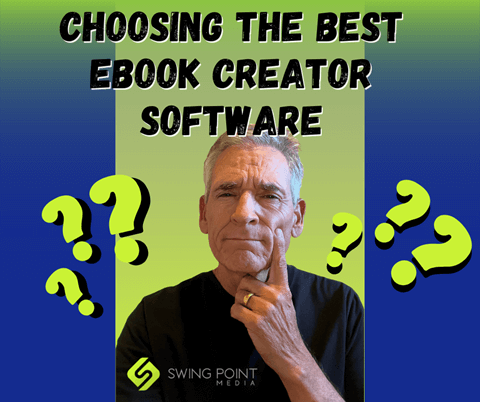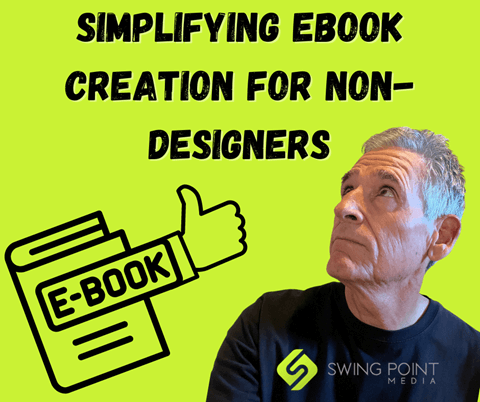Building a brand today goes beyond just slapping your logo on everything. Smart business owners are turning to eBook creators for brand building, leveraging the power of digital books to connect with audiences and drive long-term growth. They’re not only about cluing in readers; they’re also killer lead magnets that keep giving back.
If you’ve been looking for ways to pack more punch into your content marketing or want strategies for keeping those pages fresh over time, this piece is set up just right for you. We’ll dive into using top-notch eBook creation software and templates that make design accessible even if you’re not the next big-shot graphic designer.
Get ready to repurpose like a pro and push your promotions out where the eyes are—social media platforms—and watch as these insights help transform how people see your brand.

Local businesses, especially the ones that are maybe too small to be managed by a marketing company, often struggle to be found by new customers on the internet. SwingPointMedia recognizes this and has created a podcast for local businesses, sharing strategies and tactics that can be applied to help you grow. In addition, SwingPointMedia offers affordable guidance and coaching to local business owners who want or need to “do it themselves” with a goal to reduce and eliminate wasted time and money chasing the wrong “best strategy” for your business.
Table Of Contents:
- The Power of eBooks in Content Marketing
- Designing Engaging eBooks with the Right Tools
- Crafting Your eBook Content Effectively
- Simplifying eBook Creation for Non-Designers
- Conclusion
The Power of eBooks in Content Marketing
EBooks have become the Swiss Army knife for savvy content marketers. They slice through the noise, giving brands a way to share deep dives into topics that matter to their audience.
eBooks as a Valuable Source of Information
Consider eBooks your secret agents on a mission: establish thought leadership and trust with your readers. It’s not just about churning out pages; it’s crafting content so valuable that nearly three-quarters of marketers use them to rope in new leads. When you do it right, these digital powerhouses work around the clock, delivering insights and solutions straight into the hands of eager readers.
But here’s where it gets juicy—eBooks don’t just drop knowledge bombs; they’re lead-generation ninjas too. An eBook is more than just words on a screen—it’s an invitation to connect and learn together.
Maximizing eBook Lifespan for Business Growth
You’ve seen them—the dusty digital shelves filled with forgotten eBooks from yesteryear. Don’t let yours join that sad club. To keep your eBook fresh as tomorrow’s headlines, consider updating stats or incorporating emerging trends relevant to your field. This isn’t about slapping on some new paint but ensuring each page resonates with long-term value—a key ingredient missing from those one-hit wonders.
Maintaining relevance isn’t rocket science; it’s commitment mixed with smart updates based on user feedback or industry shifts. The average shelf life doesn’t need to be short-lived when you strategize for endurance right from day one.
Research by Content Marketing Institute suggests this evergreen approach makes sense because businesses like yours can continue benefiting without reinventing the wheel every quarter.
Remember—we’re not baking cookies here; we’re building empires—one insightful chapter at a time.
Key Takeaway:
EBooks are content marketing multitools, cutting through the clutter to deliver valuable insights and capture leads. They’re not just one-off projects; keep them updated with fresh data and trends to stay relevant and fuel business growth.
Designing Engaging eBooks with the Right Tools
If you’re in the game of content marketing, consider this: eBooks are not just a bunch of text on digital paper. They’re your brand ambassadors dressed to impress. Crafting an eBook that pops off the screen requires more than just solid content—it demands design swagger and creation savvy.
Choosing the Best eBook Creator Software

To turn heads and captivate readers, start by picking a heavyweight champion from the ebook creator software list. Think about it like dating—you need compatibility, something that vibes with your style and doesn’t ghost you when you hit a tech snag. With 74% of readers leaning towards eBooks jazzed up with visuals, your choice here is critical.
The matchmaking process for finding that perfect ebook creator tool can be as daunting as scrolling through Netflix on Friday night—but fear not. Whether it’s crafting ebooks pdf ready or diving into formats including ePub for Apple Books lovers; top-tier tools give you file types flexibility without breaking a sweat.
| Software | Price | Pros | Cons |
| Adobe InDesign | $20.99/month (individual), $52.99/month (Creative Cloud bundle) | – Professional features for full control – Collaboration tools – Thousands of Adobe fonts – Great for interactive ebooks | – Higher learning curve compared to simpler tools |
| Beacon | Free WordPress plugin | – Design lead magnets for WordPress – Convert website content into lead magnets – Pdf download | – Limited to WordPress users |
| Blurb | $4.99 for PDF ebook, $9.99 for fixed ebook layout with iPad support | – Publishing and physical printing support – Display books on Blurb’s bookstore – Professional quality ebook design editor | – Additional costs for different formats |
| Canva | Free plan available, Paid plan ($119.99/year) | – 1035 templates for ebooks – Easy-to-use editor – Free plan available – Can add animations to ebooks – Marketing tools built-in | – Granular control requires a paid plan |
| Designrr | Standard ($29/month), Pro ($39/month), Premium ($49/month), Business ($99/month) | – Ultimate creator for converting blogs, videos, podcasts into ebooks – Copyright-free image library – Image editor – One-click ebook publishing | – Monthly subscription costs may be high for some users |
| Draft2Digital | 10% cut of sales, free for formatting and updating | – Automated conversion and layout – Dedicated author homepage – Distribution to major online retailers – Manage and track ebooks with reports | – Takes a percentage cut of sales |
| FlipHTML5 | Free plan available, Pro ($15/month), Platinum ($35/month), Enterprise ($99/month) | – Interactive HTML5 digital publishing platform – Fully customizable flipbook templates – Online editor with multimedia support – Ebook statistics | – Free plan limitations, pricing may be high for some users |
| Flipbuilder | Flip PDF Plus ($129), Plus Pro ($399), Corporate ($1299) | – Support for converting pdfs into magazines, brochures, and catalogs – Ready-made templates – Rich media support – Mobile responsive designs | – Some users find the dashboard clunky |
| FlippingBook | Plans start from $19/month | – Professional tool to convert PDFs into digital flipbooks – Multiple sharing options – Statistics for performance evaluation | – Monthly subscription cost |
| Flipsnack | Plans start from $14/month | – Online design tool with a drag and drop interface – 1000+ professional templates – Collaboration tools – Privacy options for flipbooks | – Monthly subscription cost |
| Google Docs | Free | – Cloud-based, work is saved on Google Drive – Supports both .pdf and .epub formats – Collaborative editing | – Limited formatting features compared to dedicated ebook tools |
| Kindle Create | Free | – Professionally designed themes – Automated suggestions for styling – Preview ebooks for various devices | – Limited to publishing for Kindle |
| Kitaboo | Free trial available, Customized quotes | – Support in 25 languages – EPUB conversion support – User analytics – Support for images, videos, audio – Secure online book distribution | – Pricing not transparent, requires contacting for a quote |
| Kotobee | Basic ($150), Premium ($300), Institutional ($2000) | – Easy ebook branding – Support for audio, video, widgets – Export to more than 12 ebook formats – LMS integration | – One-time payments may be high for some users, especially for Institutional plan |
| Lucidpress (Marq) | Free plan available, Pro ($10 month), Team ($12/member with 3 members allowed) | – Supports multiple kinds of printed materials – Drag and drop editor – Access to brand asset hub – Customizable templates | – Free plan limited to 3 documents a month |
| Microsoft Word | One-time payment of $159.99 or Office 365 subscription ($6.99/month) | – Familiar interface for many users – Powerful for document formatting – Easy table of contents creation | – Can only publish in PDF format |
| Pages | Free (macOS) | – User-friendly with pre-loaded ebook templates – Supports both pdf and epub formats – Direct publishing to Apple Books | – Limited to macOS users |
| Pressbooks | Free (5 MB storage), Paid plans start from $19.99 (one-time/one book) | – Create content in PDF or EPUB format – Add annotations, quizzes, and interactive elements – Support for educators | – Free plan has limitations, paid plans required for additional features |
| Scrivener | $59.99 (full version license), $50.99(student/academic) | – Tailor-made for big projects – Break down pages into custom-sized sections – Accessible research material while writing – Support for different publishing formats | – Some users may find it overwhelming for smaller projects |
| Sigil | Free | – Open-source, free ebook creator – Import and edit in multiple formats – Supports audio, video, and images – Epub format support | – May lack advanced features compared to commercial tools |
| Ulysses | $5.99/month, custom pricing for businesses | – Distraction-free interface – Built-in proofreading and editing assistant – Set deadlines and goals – Texts accessible across devices | – Subscription cost may be a concern for some users |
| Vellum | Ebooks package ($199), Ebooks + Print package ($249.99) | – Automatic setup of margins, page numbers, etc. – Easy import of manuscripts – Browse templates – Preview ebooks for different devices | – Paid software, may be expensive for some users, only for MacOS |
| Visme | Free plan available, Personal ($15), Business ($29) | – Easy customization – Can create interactive books – Ebook templates available – Drag and drop editor – Used by popular companies like IBM, Intuit, and PayPal | – Limited storage in the free plan |
Incorporating Visuals with Adobe InDesign
Sure, Adobe InDesign might sound like it’s reserved for graphic designer elites sipping artisan coffee while adjusting their berets—however, let’s bust that myth right now. This powerhouse lays out pages like Michelangelo painted ceilings—with divine precision—and believe me when I say anyone can jump aboard this train.
Packing visual elements into your work isn’t vanity; it’s sanity if engaging eBooks are what you’re after. Here’s why: those visuals aren’t just pretty faces—they boost comprehension too. And get this—a whopping 71% are likely to share an eBook if they find value in its contents (or maybe because they want others to marvel at its beauty).
Crafting Your eBook Content Effectively
Creating content for your eBook that strikes a chord with your target audience is like hitting the bullseye in archery—it requires focus, precision, and an understanding of where to aim. As 68% of readers view eBook authors as experts, presenting compelling content isn’t just recommended; it’s crucial for cementing your reputation.
Repurposing Content Across Platforms
Diversifying how you share information can transform a single idea into multiple streams of engaging material. Picture this: You’ve got a stellar chapter on ebook marketing—why not break it down into bite-sized blog posts or riveting podcast episodes? It’s about getting more mileage out of every word penned. Repurpose into other forms of content and watch as each adaptation helps funnel different segments back to your original work—the mighty eBook.
The key here is continuity without redundancy. Whether you’re creating videos from chapters or social media snippets from key takeaways, each piece should entice audiences back to the source—a well-crafted free guide available at their fingertips.
Utilizing Social Media for eBook Promotion
Social platforms are today’s bustling marketplaces where ideas spread like wildfire. By strategically promoting eBooks through these channels, you’re not only showcasing digital products but also inviting potential leads into deeper conversations around topics they care about. This approach has dual benefits: establishing thought leadership while generating leads eager to learn more.
A smart move could be offering previews via tweets or Instagram stories linked directly to Amazon Kindle pages—or perhaps starting discussions within LinkedIn groups related directly to themes within your book. Remember that engagement goes beyond likes and shares; real success blooms when dialogue begins and connections form because someone found value in what you had shared online—a clear win-win.
Key Takeaway:
Hit your target audience right in the feels by crafting eBook content that showcases you as an expert. Think like an archer—focus and precision are key.
Multiply your reach. Break down a killer eBook chapter into blog posts or podcasts to drive readers back to your main event—the eBook.
Use social media smarts for promotion; tease with previews, spark conversations, and build connections that convert followers into fans—and leads.
Simplifying eBook Creation for Non-Designers

Creating an eBook shouldn’t feel like you’re climbing Everest. Thankfully, tools like Kindle Create are making it easier than ever. With a user-friendly interface, even business owners who don’t know their RGB from their CMYK can produce professional eBooks.
Getting Started with Kindle Create for Authors
You’ve got words and ideas that could fill pages, but the thought of formatting might send shivers down your spine. Fret not. Kindle Create is here to smooth out those bumps in the road to publishing on Amazon’s vast platform. This nifty software transforms your text into a polished ePub file without needing you to code or design anything yourself.
The best part? It’s as simple as piecing together a puzzle — just add sections, choose styles, and watch your manuscript come alive. And when we say ‘come alive,’ we mean dynamic themes that make readers stick around longer than they planned.
Using Microsoft Word and Google Docs Templates
If you prefer sticking closer to familiar ground, templates in Microsoft Word and Google Docs are lifesavers—like floaties while swimming in deep waters of content creation. No need to start working from scratch when there are plenty of pre-designed layouts at your fingertips.
MS Word templates, known by nearly every business owner since they first booted up a computer, give structure to those Word documents itching for transformation into something more impactful—a free guide perhaps?
Diving deeper into practicality without fluff: these word processing powerhouses let Mac users bask in compatibility too; imagine seamlessly switching between devices while drafting the next digital product destined for success.
With both options ready-to-go and easily accessible online ebook previews included within each program’s toolkit—it won’t be long before what started as scribbles turns into sales.
Remember how I mentioned earlier about no heavy lifting required? That applies here too because converting PDF files is also off your plate now thanks largely to our friends over at Adobe InDesign (though this one does call forth some extra skill level).
Now roll up your sleeves and let those creative juices flow, because creating an engaging narrative is key. So dive in, start brainstorming, and bring your vision to life with flair.
Key Takeaway:
Don’t sweat the tech stuff if you’re not a designer. Kindle Create and familiar tools like MS Word make eBook creation a breeze, turning your ideas into polished eBooks without needing to learn code or design.
With ready-to-use templates and easy conversion, even non-techies can craft professional-looking content that’s set to dazzle on any device—no heavy lifting required.
Conclusion
So, you’ve explored the world of eBook creators for brand building. You know now that eBooks are not just a read—they’re lead magnets and brand builders.
You’ve seen how design matters and got clued into tools like Adobe InDesign. They turn your content from drab to fab without needing a graphic designer’s chops.
You’ve learned to craft content that sticks with your audience—because what’s an expert without followers? And repurposing? It’s the secret sauce for stretching that single eBook across platforms galore.
You started with complex ideas but ended up with simple solutions, even if design isn’t your strong suit. Kindle Create, MS Word, Google Docs—they’ve got you covered.
Take these nuggets of wisdom; they’re practical and ready to use. Let them guide you as you build out those digital shelves with eBooks that don’t just sit there—they work hard for your brand.

